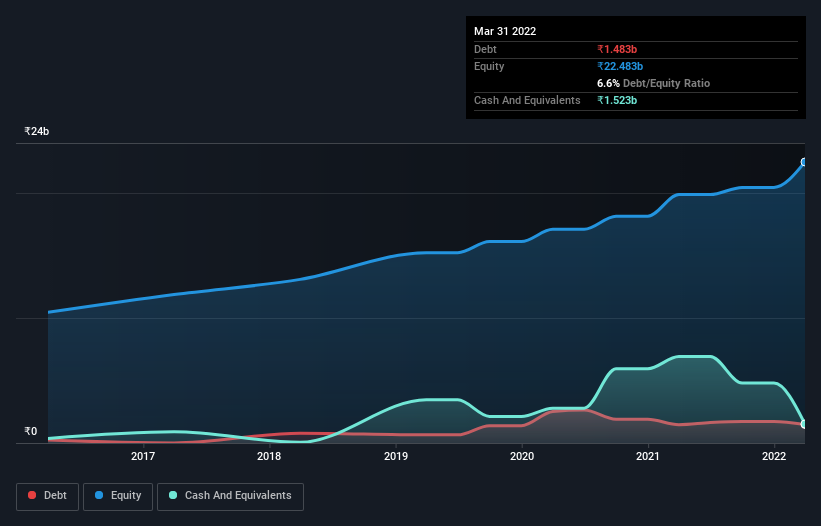- India
- /
- Metals and Mining
- /
- NSEI:RATNAMANI
Is Ratnamani Metals & Tubes (NSE:RATNAMANI) A Risky Investment?

David Iben put it well when he said, 'Volatility is not a risk we care about. What we care about is avoiding the permanent loss of capital.' When we think about how risky a company is, we always like to look at its use of debt, since debt overload can lead to ruin. As with many other companies Ratnamani Metals & Tubes Limited (NSE:RATNAMANI) makes use of debt. But the real question is whether this debt is making the company risky.
Why Does Debt Bring Risk?
Generally speaking, debt only becomes a real problem when a company can't easily pay it off, either by raising capital or with its own cash flow. In the worst case scenario, a company can go bankrupt if it cannot pay its creditors. However, a more usual (but still expensive) situation is where a company must dilute shareholders at a cheap share price simply to get debt under control. By replacing dilution, though, debt can be an extremely good tool for businesses that need capital to invest in growth at high rates of return. When we think about a company's use of debt, we first look at cash and debt together.
Check out our latest analysis for Ratnamani Metals & Tubes
What Is Ratnamani Metals & Tubes's Debt?
As you can see below, Ratnamani Metals & Tubes had ₹1.48b of debt, at March 2022, which is about the same as the year before. You can click the chart for greater detail. But it also has ₹1.52b in cash to offset that, meaning it has ₹40.4m net cash.

How Healthy Is Ratnamani Metals & Tubes' Balance Sheet?
We can see from the most recent balance sheet that Ratnamani Metals & Tubes had liabilities of ₹5.66b falling due within a year, and liabilities of ₹1.48b due beyond that. Offsetting this, it had ₹1.52b in cash and ₹6.01b in receivables that were due within 12 months. So it actually has ₹391.1m more liquid assets than total liabilities.
Having regard to Ratnamani Metals & Tubes' size, it seems that its liquid assets are well balanced with its total liabilities. So it's very unlikely that the ₹125.4b company is short on cash, but still worth keeping an eye on the balance sheet. Succinctly put, Ratnamani Metals & Tubes boasts net cash, so it's fair to say it does not have a heavy debt load!
Also positive, Ratnamani Metals & Tubes grew its EBIT by 21% in the last year, and that should make it easier to pay down debt, going forward. The balance sheet is clearly the area to focus on when you are analysing debt. But you can't view debt in total isolation; since Ratnamani Metals & Tubes will need earnings to service that debt. So if you're keen to discover more about its earnings, it might be worth checking out this graph of its long term earnings trend.
Finally, a business needs free cash flow to pay off debt; accounting profits just don't cut it. Ratnamani Metals & Tubes may have net cash on the balance sheet, but it is still interesting to look at how well the business converts its earnings before interest and tax (EBIT) to free cash flow, because that will influence both its need for, and its capacity to manage debt. Considering the last three years, Ratnamani Metals & Tubes actually recorded a cash outflow, overall. Debt is usually more expensive, and almost always more risky in the hands of a company with negative free cash flow. Shareholders ought to hope for an improvement.
Summing up
While we empathize with investors who find debt concerning, you should keep in mind that Ratnamani Metals & Tubes has net cash of ₹40.4m, as well as more liquid assets than liabilities. And we liked the look of last year's 21% year-on-year EBIT growth. So we don't have any problem with Ratnamani Metals & Tubes's use of debt. When analysing debt levels, the balance sheet is the obvious place to start. However, not all investment risk resides within the balance sheet - far from it. For example, we've discovered 2 warning signs for Ratnamani Metals & Tubes (1 is potentially serious!) that you should be aware of before investing here.
At the end of the day, it's often better to focus on companies that are free from net debt. You can access our special list of such companies (all with a track record of profit growth). It's free.
New: AI Stock Screener & Alerts
Our new AI Stock Screener scans the market every day to uncover opportunities.
• Dividend Powerhouses (3%+ Yield)
• Undervalued Small Caps with Insider Buying
• High growth Tech and AI Companies
Or build your own from over 50 metrics.
Have feedback on this article? Concerned about the content? Get in touch with us directly. Alternatively, email editorial-team (at) simplywallst.com.
This article by Simply Wall St is general in nature. We provide commentary based on historical data and analyst forecasts only using an unbiased methodology and our articles are not intended to be financial advice. It does not constitute a recommendation to buy or sell any stock, and does not take account of your objectives, or your financial situation. We aim to bring you long-term focused analysis driven by fundamental data. Note that our analysis may not factor in the latest price-sensitive company announcements or qualitative material. Simply Wall St has no position in any stocks mentioned.
About NSEI:RATNAMANI
Ratnamani Metals & Tubes
Manufactures and sells stainless steel pipes and tubes, and carbon steel pipes in India and internationally.
Flawless balance sheet with moderate growth potential.
Similar Companies
Market Insights
Community Narratives



